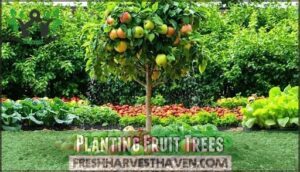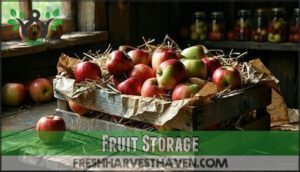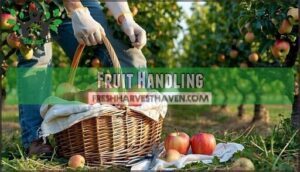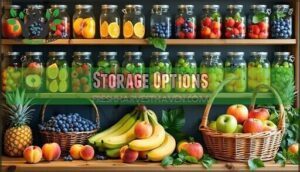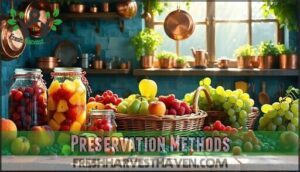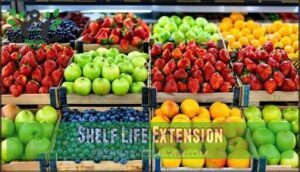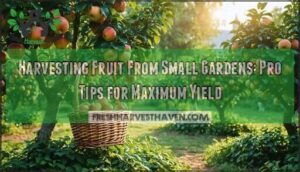This site is supported by our readers. We may earn a commission, at no cost to you, if you purchase through links.
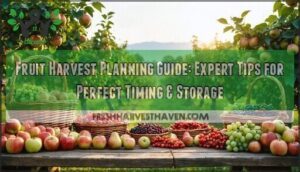
You’ll want to pick fruits when they’re ripe but still firm – think of it as catching them at their peak performance.
Different fruits mature at different rates, so apples won’t follow the same schedule as your strawberries.
Climate plays a huge role too, and your local frost dates and heat tolerance will determine which varieties thrive in your garden.
Storage matters just as much as picking, with cool, dry conditions working best for apples, while berries need refrigeration.
A solid fruit harvest planning guide covers variety selection, proper timing techniques, and storage methods that’ll maximize your bounty, considering the importance of peak performance.
Table Of Contents
- Key Takeaways
- Fruit Harvest Timing
- Choosing Fruit Varieties
- Planting Fruit Trees
- Harvesting Techniques
- Post Harvest Care
- Frequently Asked Questions (FAQs)
- How to harvest fruit effectively and easily?
- Do you need special equipment to harvest fruit?
- Should you harvest fruits from your garden?
- What tools do you need to harvest fruits?
- Why is harvesting a fruit important?
- How do you harvest fruit & vegetables?
- What not to plant next to fruit trees?
- What is the easiest fruit to harvest?
- How do you know when fruit is ready to be picked?
- What fruit takes the longest to harvest?
- Conclusion
Key Takeaways
- Match your fruit varieties to your local USDA zone and climate conditions – You’ll save yourself heartache by choosing fruits that naturally thrive in your area rather than fighting against nature with exotic varieties that won’t survive your winters or summers.
- Time your harvests using all your senses, not just sight – You’ll know fruit’s ready when it releases easily from the branch, smells sweet, and passes the taste test, since picking too early leads to sour disappointment while waiting too long gives you mushy compost material.
- Handle your harvest like precious cargo to maximize shelf life – You’ll prevent bruising and extend freshness by using proper tools, picking on dry days, and storing different fruits according to their specific needs (berries in the fridge immediately, apples in cool humidity).
- Plan your storage strategy before you harvest, not after – You’ll avoid waste by matching your fruit quantities to your family’s consumption habits and storage capacity, since there’s no point growing fifty pounds of peaches if everyone prefers apples.
Fruit Harvest Timing
You can’t harvest every fruit the same way because timing depends on your local climate, fruit type, and current weather conditions.
Think of it like catching a bus – miss the perfect window and you’ll either get sour, unripe fruit or mushy, overripe disappointment that belongs in the compost bin, which is a result of poor harvest planning.
Fruit harvesting is like speed dating – timing is everything, and one bad pick ruins the whole experience.
Climate Considerations
Your local climate sets the stage for harvest success.
Regional variations determine which fruits thrive in your area—apples need chill hours while mangoes prefer constant warmth.
Track frost dates religiously to protect delicate blooms.
Microclimates create pockets of opportunity; that south-facing wall might extend your growing season.
Weather conditions during harvest matter too.
Sunlight needs vary by fruit type, so understanding your climate zone helps you plan harvests that deliver peak flavor.
Fruit Type Variations
Different fruit varieties demand distinct harvest approaches that’ll make or break your timing. Berry ripening happens fast – strawberries and blueberries need daily checks during peak season.
Stone fruit like cherries requires gentle handling to prevent bruising. Pome characteristics mean apples need staggered picking as they ripen unevenly.
Here’s what drives successful fruit harvest planning:
- Citrus qualities thrive in consistently warm zones
- Tropical needs require completely frost-free environments
- Growth habits determine long-term orchard success
Weather Conditions
Weather conditions make or break your harvest success.
Check frost dates early—they’ll save your crop from surprise cold snaps. Microclimates impact ripening, so monitor sheltered spots versus open areas.
Perfect harvesting conditions mean dry, sunny days without wind or rain.
Temperature swings affect ripening quality, so track local climate patterns daily. Smart weather monitoring turns guesswork into harvest forecasting gold.
Choosing Fruit Varieties
You’ll want to match your fruit choices to your local climate and growing zone, just like picking the right coat for winter weather.
Consider your family’s taste preferences and storage space before selecting varieties, since there’s no point growing fifty pounds of peaches if everyone prefers apples.
Climate Suitability
Before choosing fruit varieties, match them to your USDA Zones and local climate patterns.
Chill Hours determine whether apples will fruit, while Heat Tolerance decides if peaches survive summer scorchers.
Regional Variations create Microclimate Effects – that sunny south wall might grow citrus in zone 7.
Smart climate considerations turn backyard corners into productive orchards despite challenging weather conditions.
Family Preferences
Beyond climate matching, your family preferences shape smart variety selection for successful fruit harvest planning.
Consider these key factors when choosing fruit varieties:
- Flavor profiles – Pick sweet snacking fruits or tart cooking varieties based on your family’s taste preferences and dietary needs
- Fruit quantities – Match harvests to realistic consumption and storage capacity
- Usage alignment – Time pickings with your family’s eating habits to minimize waste
Native Temperate Fruits
After considering family preferences, native temperate fruits deserve your attention for successful fruit harvest planning.
These regional champions offer natural pest resistance and require minimal intervention compared to exotic varieties. Your local climate has shaped these fruits over centuries, making them reliable producers.
Native temperate fruits are like old friends—dependable, familiar, and perfectly suited to your neighborhood.
Your fruit harvest is like a symphony—every note must hit at precisely the right moment for perfect harmony.
Consider these advantages when selecting native fruit varieties:
- Local Adaptation: They’re naturally suited to your soil and weather patterns
- Pollinator Needs: Native bees and insects already know these blooms
- Historical Significance: Time-tested varieties with proven harvest success
These fruits form the backbone of effective harvest planning. When choosing, remember that climate and micro-climate are critical considerations.
Warm Climate Fruits
Unlike temperate varieties, warm climate fruits demand frost-free zones and consistent heat. You’ll find success with citrus varieties like oranges and lemons in USDA zones 9-11.
Mango cultivation requires temperatures above 40°F year-round, while avocado ripening happens best in Mediterranean-style climates. Fig propagation thrives in hot, dry summers, and guava care needs protection from any frost.
| Fruit Type | Harvest Season | Storage Method |
|---|---|---|
| Citrus | Fall-Spring | Refrigerate 2-3 weeks |
| Mango | Summer | Counter ripen, then cool |
| Avocado | Year-round | Room temp until soft |
| Fig | Late summer | Dry or freeze |
| Guava | Fall-Winter | Eat fresh quickly |
Your fruit harvest planning succeeds when climate suitability matches your growing zone perfectly.
Planting Fruit Trees
You’ll want to plant your fruit trees in spring when the soil crumbles in your hand rather than sticking to it like mud on a rainy day.
Choose a sunny spot with well-drained soil and give your trees proper spacing so they won’t compete for resources like siblings fighting over the last slice of pie.
Site Selection
Your fruit trees deserve the perfect spot to thrive. Smart site selection sets the foundation for years of abundant harvests ahead.
Sunlight exposure makes or breaks your success. Choose locations receiving eight hours of direct sun daily. Poor soil drainage kills more trees than pests ever will. Wind protection shields delicate blossoms from damage, while understanding your USDA growing zones and garden microclimates helps match varieties to available space.
- Full sun locations with southern exposure maximize fruit production
- Well-draining areas where water doesn’t pool after heavy rains
- Sheltered spots protected from harsh winds and extreme weather
Soil Preparation
Think of soil preparation as laying the foundation for your fruit tree’s future success.
Start with soil testing to check soil pH levels—aim for 6.0 to 7.0 for ideal nutrient balance. Poor drainage solutions spell disaster, so avoid waterlogged spots.
Enrich your fruit tree soil with organic matter like compost before planting fruit trees. Proper site selection includes evaluating soil depth for healthy root development.
Amending the soil is vital, especially if you’re dealing with sandy soil limitations.
Tree Spacing
Smart tree spacing sets the foundation for successful fruit harvest planning.
Your garden size determines whether you’ll choose dwarf rootstocks or standard varieties.
Here’s what proper spacing delivers:
- Sunlight access – Each tree gets 8+ hours of direct sun
- Overcrowding prevention – Reduces competition for nutrients and water
- Pollinator proximity – Bees navigate easily between flowering branches
Strategic orchard management starts with giving your fruit trees breathing room.
Irrigation Systems
After spacing your trees properly, irrigation systems become your orchard’s lifeline.
Drip irrigation delivers water directly to roots while conserving precious resources.
Sprinkler systems work well for larger areas but use more water.
Selecting the right system depends on factors like crop needs and climate, so it’s important to understand irrigation system types.
System maintenance keeps everything running smoothly for maximum crop yield:
- Monitor soil moisture levels weekly using sensors or finger tests
- Flush drip lines monthly to prevent clogs and guarantee consistent flow
- Adjust watering schedules based on weather and fruit production stages
Smart water conservation equals better harvest planning!
Harvesting Techniques
You’ve planted your fruit trees and watched them grow, but now comes the moment of truth – getting those precious fruits from branch to basket without turning them into expensive compost.
The right harvesting techniques can mean the difference between enjoying perfect peaches for weeks or watching them turn to mush faster than you can say "fruit salad.
Tool Selection
When harvest season arrives, your fruit picking tools can make or break your success.
Fruit pickers with telescoping poles reach those stubborn high branches, while harvesting bags prevent bruising delicate produce.
Sharp pruner types work best for cherries and grapes. Don’t forget garden gloves for thorny raspberries!
Tool cleaning between different fruits prevents disease spread.
Smart tool selection matches your specific fruit harvest equipment needs to each variety you’re growing. Consider using specialized picking devices to ease the harvesting process.
Handling Methods
Your fruit harvest success hinges on mastering gentle handling techniques that preserve quality and extend shelf life.
Proper handling methods prevent bruising and maintain freshness from tree to table.
Follow these essential handling practices:
- Wear protective gear – Use clean gloves to prevent contamination and protect hands from thorns
- Practice tool sanitation – Clean pruners between trees to avoid spreading disease
- Preserve stems intact – Use scissors for delicate fruits like cherries to maintain natural barriers
- Execute staged harvest – Pick fruits at different ripeness levels to maximize quality
Harvest Scheduling
Proper harvest scheduling maximizes your fruit harvest through strategic planning.
Track ripening stages to identify peak flavor timing for each variety. Use staggered harvest methods to extend picking seasons and align with your storage capacity. Monitor usage alignment to prevent waste.
Here’s your efficient planning framework:
| Timing Strategy | Best Practice |
|---|---|
| Early Morning | Sweeter, crisper fruits |
| Ripeness Check | Daily monitoring needed |
| Weather Watch | Avoid wet conditions |
Fruit Storage
After picking your treasures, storage conditions determine how long you’ll enjoy them. Smart fruit preservation keeps your harvest fresh for weeks instead of days.
Proper fruit picking is essential for minimizing damage.
- Choose breathable containers that allow airflow for ideal fruit quality
- Use cold storage in your refrigerator to slow the ripening process
- Separate ethylene producers like apples from sensitive fruits
- Check daily for spoilage during post harvest care
- Control humidity with proper fruit handling and preservation techniques
Post Harvest Care
Once you’ve picked your fruit, your work isn’t finished – think of it like babysitting a toddler who bruises easily and spoils when you’re not watching.
You’ll need to handle each piece gently and store it properly to maximize shelf life, whether that means letting pears ripen on your counter or tucking apples away in the fridge for months of crisp snacking.
Fruit Handling
Right off the bat, your fruit harvest demands careful attention. Gentle Picking protects delicate skin while Stem Preservation prevents entry points for bacteria.
Sort immediately, removing damaged pieces to stop spoilage spread.
| Handling Step | Key Action |
|---|---|
| Protective Gear | Wear gloves for thorny fruits |
| Tool Cleaning | Sanitize pruners between trees |
| Harvest Stages | Pick firmest fruits first |
| Quality Check | Remove bruised specimens immediately |
Storage Options
Smart fruit storage transforms your harvest from days to weeks of fresh eating.
Your storage strategy depends on each fruit’s unique needs and natural ripening effects. Temperature control and ideal humidity create the perfect environment for extended shelf life.
Here are five essential fruit storage techniques:
- Refrigerate berries immediately – Cold storage at 32-35°F stops deterioration and maintains firmness for up to two weeks.
- Store apples in high-humidity drawers – Crisp conditions prevent shriveling and preserve crunch for months.
- Use ventilated containers for stone fruits – Air circulation prevents mold while allowing controlled ripening.
- Keep tropical fruits at room temperature – Cold damages bananas and mangoes, causing blackening and flavor loss.
- Separate ethylene producers – Container selection matters since apples release gases that speed ripening in nearby fruits.
Consider using specialized fruit containers for optimal preservation.
Preservation Methods
Several proven preservation methods let you capture summer’s sweetness year-round.
Freezing fruits works best for berries – just wash, dry, and store in airtight containers.
Drying methods create concentrated flavors through dehydration. Canning techniques preserve whole fruits in syrup, while fruit leathers offer chewy snacks kids love.
Fermentation adds probiotics to your fruit storage arsenal. For specialized equipment, consider options for efficient fruit freezing.
Each fruit preservation technique extends your harvest’s life substantially.
Shelf Life Extension
Smart harvesting sets the stage, but extending shelf life requires strategic post-harvest techniques.
You’ll maximize freshness by combining proven fruit storage methods:
- Cold Storage drops temperatures to slow respiration and delay ripening
- Modified Packaging creates controlled atmosphere environments that reduce oxygen levels
- Edible Coatings from natural sources form protective barriers against moisture loss
- Irradiation Effects eliminate harmful bacteria while preserving nutritional value
These fruit preservation techniques can double your harvest’s lifespan.
To prevent spoilage, inspect produce regularly.
Frequently Asked Questions (FAQs)
How to harvest fruit effectively and easily?
Harvest fruit when it’s ripe by using your senses—taste, touch, and smell.
Pick on dry, calm days using proper tools like pruners and baskets.
Handle gently to avoid bruising and damage.
Do you need special equipment to harvest fruit?
Like a painter needs brushes, you’ll want basic harvesting tools.
Pruners cut stems cleanly, baskets collect your bounty, and fruit pickers reach high branches.
Garden gloves protect hands from thorns—simple gear makes harvesting easier.
Should you harvest fruits from your garden?
You’ll enjoy fresher flavors, better nutrition, and peak ripeness when you harvest your own fruits. Plus, you’ll save money and know exactly how they’re grown. It’s incredibly rewarding too.
What tools do you need to harvest fruits?
You’ll need pruners for cutting stems, harvesting bags or baskets for collecting fruit, and garden gloves for protection.
Fruit pickers help reach high branches, while clean tools prevent disease spread between plants.
Why is harvesting a fruit important?
Picture a painter who knows exactly when their masterpiece is complete—that’s you timing your harvest perfectly.
You’ll capture peak flavor, maximize nutrition, prevent waste, and guarantee proper storage by picking fruits at their prime ripeness moment, which ensures you’ll also capture the best nutrients.
How do you harvest fruit & vegetables?
Harvest fruits when they’re ripe by gently twisting or cutting them from branches. Pick vegetables at peak freshness using clean tools. Handle produce carefully to avoid bruising and preserve quality.
What not to plant next to fruit trees?
Crowded roots compete fiercely underground.
Don’t plant shallow-rooted vegetables, competitive grasses, or walnut trees near fruit trees.
They’ll steal water and nutrients, weakening your harvest.
Keep them separate for healthier, more productive trees.
What is the easiest fruit to harvest?
Strawberries take the crown as the easiest fruit you’ll harvest. They’re low to the ground, ripen quickly, and you’ll know they’re ready when three-quarters turn red—no ladders required!
How do you know when fruit is ready to be picked?
When Sarah picked her first apple, it tasted sour and bitter—a classic rookie mistake.
You’ll know fruit’s ready when it releases easily from the branch, smells sweet, and passes the taste test without puckering your face.
What fruit takes the longest to harvest?
Large tree fruits like apples and pears typically take the longest to harvest since you’ll need to pick them in stages over several weeks.
Checking different branches as individual fruits ripen at varying rates.
Conclusion
Rome wasn’t built in a day, and neither is a successful fruit garden.
Your fruit harvest planning guide success depends on matching varieties to your climate, timing harvests perfectly, and storing produce properly.
Remember that apples need cool storage while berries require immediate refrigeration.
Start small with reliable varieties suited to your area, then expand as you gain experience.
With proper planning and timing, you’ll enjoy fresh, homegrown fruit from spring strawberries through late-season apples, which is the ultimate goal of a well-planned fruit garden.



